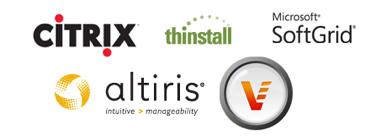Introduction
In preparation for this article, we set out to find a simple definition of application virtualization. All we wanted was a simple and concise introductory sentence to give our readers a good idea of what application virtualization is all about, independent of the meanings given by the existing software vendors that tout the advantages of application virtualization.
The search turned out to be rather difficult, as it seems the different companies pursuing the technology are defining what it means. It is not our intention to declare a "winning technology" in this article; the fact is that all the products we'll have a look at have a slightly different focus. Instead, the goal is to provide an objective view of the technology's current possibilities for the IT market.
While the number of companies offering application virtualization is definitely growing, the bulk of the possibilities currently come from four products, namely VMware's Thinstall, Altiris' SVS (Software Virtualization Solution), Microsoft Application Virtualization (previously SoftGrid), and Citrix XenApp (previously Citrix Presentation Server). It's interesting to note that in the course of the past two years, nearly all of these products were acquired by one of the major software companies, so there's definitely interest by the big players in this field.

We hope this article will provide an interesting introduction to anyone interested in becoming more familiar with this trend.










11 Comments
View All Comments
Genx87 - Monday, February 25, 2008 - link
About 18 months ago I was introduced to VMWares virtual server. Right now I am in the beginning phases of planning for a Hyper-V envrionment which should consolidate nearly all of our servers onto a few boxes. Easier to manage, easier to backup, easier to migrate, and easier to recover from a disaster.Software virtualization looks like an awesome technology for the IT admins around the world. Being able to spit out a package to a client and roll it back if there is an issue with the latest patch while preserving the OS is a godsend.
I appluad Anandtech for taking a look at these technologies. Virtualization is the way of the future imo.
Olaf van der Spek - Monday, February 25, 2008 - link
Doesn't this basically show that installing applications and keeping them up-to-date is too hard on Windows?Sounds like proper package management instead of virtualization would go a long way to fixing this.
lopri - Monday, February 25, 2008 - link
but intro only.. :PJokes aside, I thought there would be a lot more pages in this article, until I turned to the last page. Great job, wetting others' appetite! Also a joke. Grr..
Anyway, great article and lots of information. Thanks.
ninjit - Monday, February 25, 2008 - link
Reading the article, I kept thinking of Valve's Steam game/content delivery system.If you've ever looked at at the files with the Steam folder, they look nothing like the files that would normally be installed if you had bought the game traditionally on CD/DVD (or direct download from the publisher), yet I don't believe developer's have to change much (if anything at all) in order to have their game delivered through steam.
It appears a game's installed files are placed within virtual disk-files that Steam then manages.
I'm not sure, but I think steam also virtualizes many user settings/ registry entries a game may require - I've been able to move my steam folder about willy-nilly (e.g. from my main drive to a new faster secondary one) and steam (+ my games) still work fine, the only thing that gets broken are shortcuts.
GTVic - Monday, February 25, 2008 - link
Nice article. I believe AMD and Intel are touting virtualization support in their newest CPUs/chipsets particularly on the server side.Is this "hardware" virtualization another type of virtualization. Some info on that would be a nice addition.
Lizz - Monday, February 25, 2008 - link
That is in fact a different kind of virtualization, as explained on page 2 of the article.A more in-depth article on hardware virtualization will be posted very soon, so if you're interested in this subject, I'd suggest waiting on that. Johan will be putting it up later today, I believe. :)
smitty3268 - Monday, February 25, 2008 - link
There's an interesting Linux project called Klik2 in development that aims to provide application virtualization.Less as an enterprise solution and more as an easy way of demoing apps across multiple linux distros, I think.
Doormat - Monday, February 25, 2008 - link
"Using MAV in a streaming environment prevents any of the applications from actually being installed on the client computer (apart from the user's local settings). This means that all applications need to stream to the system over the network every time they are requested, and nothing is actually saved on the client. However, MAV does provide the option to run virtualized apps locally without the use of streaming, should the need arise."Most situations would run the streamed apps over the network the first time, and run them locally from then on. I know thats how our Softgrid is implemented at work. The plus is that Softgrid checks for upgrades whenever the app is started.
Lizz - Monday, February 25, 2008 - link
I was under the impression that only the user's local settings and profiles were saved, to minimize the amount of data saved locally on the client computer. I'll have another look at this in a bit, thanks for pointing it out!anandtech02148 - Monday, February 25, 2008 - link
Overpaid and always whinning, sure its only a few hundred machines to installed, but hey.. overtime is even better pays right?Interesting, will google's cloud computing replace this virtualization someday?